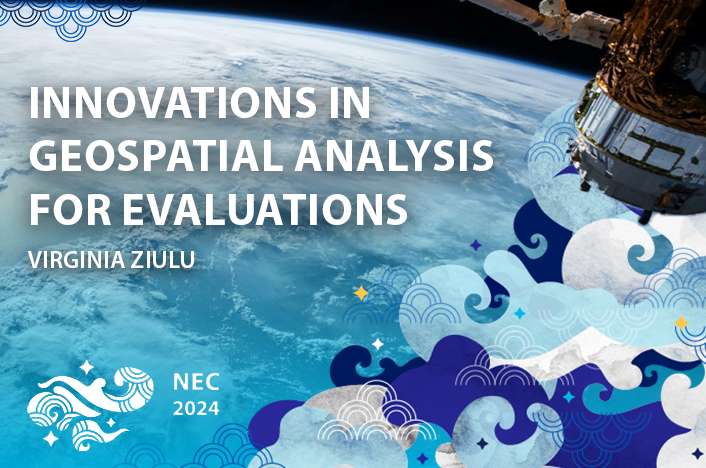
By Virginia Ziulu, Data Scientist, World Bank Independent Evaluation Group
How can we ensure that development efforts reach the places where they are most needed? This question is at the heart of evaluation and planning, and today, geospatial analysis offers a powerful tool to provide answers. Geospatial data, which includes any information tied to specific locations on Earth, is transforming the way we understand and address development challenges. From mapping crop patterns and road networks to analyzing satellite imagery and streetscape photos, geospatial analysis is becoming a cornerstone for deciphering the complexities of our interconnected world.
Until recently, the use of geospatial data, particularly satellite imagery, was limited to specialized fields such as military applications due to the massive computational power required. But times have changed. Advances in machine learning and computing have democratized access to these valuable data sources. Today, anyone with the right tools and skills can harness geospatial data to analyze phenomena on a global scale, over long periods, and with high precision.
At the World Bank Independent Evaluation Group (IEG), we are pushing the boundaries of evaluation practice by incorporating geospatial analysis into our work. This innovation is part of our mission to help evaluation professionals answer complex questions with cutting-edge methods. By exploring new techniques, such as analyzing satellite and digital images, we can better understand changes in spatial phenomena over time and evaluate the relevance and effectiveness of development interventions.
Why is this important now? As the world becomes increasingly data-driven, the ability to visualize and quantify changes across time and space is more crucial than ever. Geospatial analysis allows us to see patterns that might be invisible through other methods, making data interpretation more intuitive and actionable. Evaluations can greatly benefit from incorporating geospatial analysis. This is especially true for projects delivered in a defined geographic area (such as a transport route or a development zone) or focusing on a phenomenon which has a clear geographic dimension (such as coral bleaching, ocean litter, or agricultural crop replacement). Moreover, geospatial data, particularly satellite imagery, can serve as valuable proxies for socio-economic variables, offering better generalization, finer geographic disaggregation, and easier global accessibility, which enhances comparability across regions.
Answering Relevance Questions on Country Program Evaluations
One area where geospatial analysis is proving invaluable is in evaluating the relevance of development efforts. IEG has been piloting this approach in Country Program Evaluations (CPEs) to determine whether the World Bank and other developing partners are targeting the areas (such as regions, provinces, or cities) where needs are greatest.
In these country evaluations, we proxy both the level of need and the level of support provided by the World Bank, trying to ascertain whether there is a correspondence between the two. The level of need is assessed by disaggregating macro variables (such as GDP per capita), sector-specific variables (to proxy the level of need in terms of access to basic services such as education, health, transportation, energy), and imagery data (such as nighttime lights data, to proxy the level of access to electricity access). The level of support is determined by mapping the number of World Bank (and other development partners) project sites across the same spatial and temporal disaggregation. The analysis relies on building a customized dataset using multiple variables with geocoded data. These data are typically derived from a variety of sources, including geocoded survey data and official statistics, publicly available gridded datasets, and remote sensing data.
For example, in the CPE for Mozambique, IEG examined whether World Bank projects from 2008 to 2021 were focused on the areas most in need. The findings showed a shift in project targeting over time, with an increasing focus on poorer provinces. Similarly, in the Morocco CPE, we conducted a regional analysis to assess the geographical allocation of development resources during 2011-2021. The results highlighted disparities in how funds were distributed, with some regions receiving more support despite having lower levels of need. These insights are crucial for guiding future interventions and ensuring that development efforts are equitable and effective.
The strength of this approach lies in the ability to produce detailed subnational estimates that go beyond national averages, revealing regional disparities that might otherwise go unnoticed. Furthermore, this approach is flexible in terms of data requirements and can be highly customized based on the specific focus of the analysis, making the methodology replicable to any country context. It also relies on publicly available data and open-source tools, which makes the methodology cost-effective.
Practical Considerations
However, it's important to recognize the challenges of using geospatial analysis. The data often requires specialized knowledge and expertise to process and interpret. Despite advances in computing, working with large datasets, particularly satellite images, can still be resource-intensive. Additionally, geospatial data alone may not fully capture complex issues such as poverty or environmental degradation, making it essential to complement these analyses with on-the-ground data collection and careful validation, in the framework of a mixed-methods evaluation approach.
For governments and organizations to effectively harness geospatial analysis, it's crucial to identify when it can make the biggest impact, such as in tracking temporal and spatial changes. However, the true potential of this technology can only be realized through targeted capacity development. This means not only providing access to the necessary technology but also building the skills and infrastructure required to implement geospatial analysis effectively.
This year's National Evaluation Capacities (NEC) conference will explore these topics in greater depth. I invite you to join the Big Data panel, where I'll discuss how geospatial analysis can be seamlessly integrated into evaluation practices. We'll examine its application in measuring change over time, assessing effectiveness, and determining relevance, all illustrated with concrete examples.
Geospatial analysis is not just a tool—it's a game-changer in the world of evaluation. By embracing this innovation, we can ensure that development interventions are not only well-targeted but also responsive to the needs of those they are meant to serve.